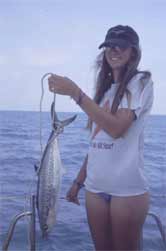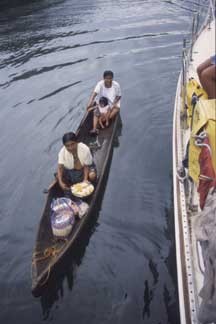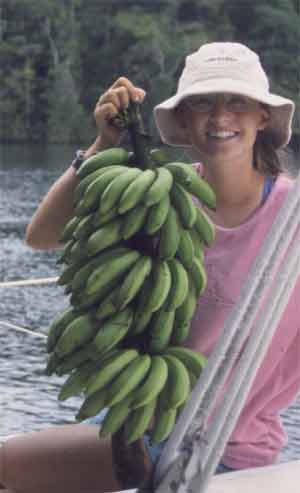No Refrigeration? No Problem!
by Barbara
Theisen
Life without refrigeration. Why would you even consider such a thing?
Well, sometimes it isn't so much a choice, like when your reefer dies and
you're in the middle of paradise - very warm paradise. You may suddenly find
you need to survive without the fridge for several weeks while waiting for
parts or waiting for someone who can service your system. Don't let lack of
refrigeration ruin your cruise.
Maybe you happily cruise with a well-running fridge but you've realized
that you can fit only so much food in your refrigerator - and it isn't
enough to last you between your provisioning stops. You need ideas that will
extend your provisions for several weeks or months without refrigeration.
Or perhaps you've chosen to live without refrigeration because of the time
and money involved in having a system aboard. To have refrigeration you will
need:
money for a good refrigeration system
money and time to build and insulate a box or at the very least reinsulate
your existing box.
money for an energy source to run the refrigeration
money or the expertise to keep it running.
I believe that you don't need to have it ALL before you go cruising. Not
everyone will be willing to give up the reefer but if you're on a tight
budget and believe - as I do - that it's much better to go cruising NOW than
wait until that elusive day when you can afford to have it all - then you
might be one of many cruisers who say, "No refrigeration? No problem."
Here are some tips for living without refrigeration.
MEAT
Most cruisers find they need to cut down on the amount of meat that they
eat. This isn't such a bad deal. You'll find that if you replace your meat
with protein sources such as freshly caught fish and dry legumes, you will
save significantly on your food bill and you'll eat a healthier diet.
Here are some ways to cut back on meat:
Simply remove the meat from some of your recipes such as in spaghetti
sauce, lasagna, soups, casseroles, etc. Add extra vegetables if needed.
Canned mushrooms for example can add "bulk" to your spaghetti sauce and are
a good source of protein.
Add beans in place of meat. Beans are a great source of protein, are
inexpensive and easy to store. They also taste great. If you are new to
eating beans, add them gradually to your diet and let your digestive system
get accustomed to them. Try a variety of beans - black, pinto, kidney,
adzuki, refried - in place of meat in Mexican dishes such as tacos, taco
salads, burritos, etc. and as a main ingredient in dishes such as Cajun
beans and rice or bean soup. I buy both dried beans and canned beans and use
the canned beans when we're on tight water rations.
Eat freshly caught fish and seafood. But unless you have ice - don't catch
more than you can eat in the next meal or two. Catching fish - either by
trolling behind the boat or by spearfishing can be lots of fun and can
actually provide you with a good supply of food in certain cruising areas.
I've actually had my kids say, "not lobster again, mom!" You may also be
able to trade for fresh fish and seafood.
Provision with canned meats. You might want to learn how to can your own
meat or you can buy canned meat. Good sources to buy canned meat are?????
Most grocery stores in the states carry canned chicken. A little six-ounce
can of cooked chicken can go a long way towards zipping up a meal such as
fajitas or a stir-fry.
Eggs are an inexpensive source of protein and can be stored without
refrigeration. Start with fresh eggs that have never been refrigerated.
Outside the US this is easy. In the US, try finding a farm that sells fresh
eggs. Do not clean the shells, as there is already a protective seal on the
eggs that you don't want to wash off. The easiest way to keep eggs for a
month or two without refrigeration is to simply turn the egg cartons over
twice a week. Powdered eggs are also available and are a great substitution
for any baking that calls for eggs in the recipe.
Try using lentils occasionally in place of ground beef or ground turkey in
dishes such as sloppy joes. No, they don't taste like meat but they are good
and the strong flavor of a sloppy joe sauce WILL make them taste sloppy
joe-ish.
Nuts are another great source of protein and they store well on a boat.
Add nuts to stir fries or salads or use peanut butter or almond butter to
make sandwiches. Nuts make a great snack as well.
Tofu is yet another source of protein. It is available packaged in aseptic
containers that need no refrigeration. Tofu has very little flavor of its
own but instead absorbs the flavor of the ingredients that it is cooked
with. Adding tofu to your meal is a great way to include the benefits of soy
in your diet.
Be creative with your cooking. I grew up eating meat as the main
ingredient at dinner. Vegetables, breads, rice or potatoes were just the
"extras." But you can build a meal around a vegetable or a rice dish.
Potatoes can be the center of attention. You just have to change your
traditional way of thinking.
When you have access to a market where meat is available and you're in
need of a carnivorous fix, plan on a meat based meal on shopping day.
If you enjoy sampling the local cuisine while cruising, go out to eat
occasionally and order a meat dish.
DAIRY PRODUCTS
Most fresh dairy products will spoil quickly without refrigeration although
an icebox will extend their life. But many products are available in forms
that need no refrigeration.
Milk
Powdered milk is the least expensive of the non-refrigerated milk
products. It stores well and is widely available. Most cruisers are able to
make the change from fresh milk to dry if it is done gradually (drink a
mixture of half fresh milk to half reconstituted powdered for a few days
then gradually increase the ratio of powdered). You may want to try adding a
bit of sugar and a drop of vanilla. Some people however, only find the milk
palatable if chilled first. That can be a problem if you have no
refrigeration to cool the reconstituted milk and you just can't stand it at
room temperature. Here's a tip to cool down any beverage (milk, beer, etc.).
Take a wet towel and wrap it around the can or bottle for a few minutes.
Evaporation will help to cool the bottle a few degrees. Even if you don't
like to drink the powdered milk, keep a good supply on hand for baking.
Remember to mix only what you will need. If you or your kids need a calcium
boost but don't like drinking the powdered milk straight, try it in hot
chocolate. Yes, my kids drink hot chocolate even in the tropics. Or add some
powdered chocolate milk mix, such as Nestle Kwik or Ovaltine.
Long-life milk is milk that has been sterilized using Ultra High
Temperature (UHT) pasteurization and sealed inside a box, so it does not
spoil even at room temperature. It needs no refrigeration until opened. Even
at room temperature you probably won't mind the taste of this on cereal. If
we plan on having cereal and milk for breakfast and open a long life milk
but have no ice in the ice box, I just plan on using some in my baking that
morning - I usually bake in the AM when its cooler anyway.
Canned milk such as evaporated milk or sweetened condensed milk is widely
available. Or you can make your own.
Sweetened Condensed Milk: Combine 1-cup instant nonfat dry milk, 2/3-cup
sugar, 1/3 cup boiling water and 3 Tablespoons of melted margarine in either
a blender or a bowl. Blend or mix with electric mixer until smooth. Makes
about 1Ό cups.
Evaporated milk: Use dry milk reconstituted with only ½ the amount of water
called for.
Cream
Canned Cream such as the Nestlι's brand is available in many ports around
the world, although you are less likely to come across it in the states.
Sour cream
To make your own sour cream, mix a six-ounce can of Nestlι's Cream with 2
teaspoons of vinegar. Stir and let stand for an hour or two.
Cheese
Remember that the harder the cheese, the longer its storage life. Parmesan
cheese and cheddar cheese are hard cheeses, whereas mozzarella and Farmer's
cheese are softer. Buy cheese sealed in a heavy wax coating, if possible. As
an alternative you can dip a piece of cheesecloth in vinegar, wrap the
cheese in this and store in the coolest part of your boat. Velveeta brand
cheese and other American cheese products need no refrigeration.
Butter
You can buy delicious canned butter that needs no refrigeration. Great
bets are canned butter from New Zealand or Ireland. You'll find canned
butter available in many ports around the world although it is difficult to
find in the US.
You can also save money by preserving your own butter. Sterilize jars with
screw on lids. Cool on a clean surface. Next, boil one-quart water and four
tablespoons of salt. Let cool. Place 2 sticks of butter (1/2 cup) in the
sterilized jar. Fill jars with cooled water/salt mixture and screw on the
tops of the jar. Your butter will keep for months.
Whipped margarine in plastic tubs will stay fresh for several months if
left unopened. Butter flavored Crisco works great for many baking recipes
and needs no refrigeration.
Yogurt
It's easy to make homemade yogurt using a thermos. Heat one quart of
reconstituted nonfat dry milk (add an additional 1/3 cup of dry milk - no
extra water - if you like thick, custard style yogurt) over medium heat just
until milk comes to a boil, stirring occasionally. Remove milk from heat.
While the milk is heating, boil a kettle of water and pour the boiling water
into the thermos to sterilize and "preheat" the thermos. Cool milk until it
reaches a temperature between 100-120 degrees Fahrenheit. Put 2 Tablespoons
of "starter" yogurt (either from your last batch of yogurt, store bought
plain yogurt that has "live" or "active" cultures, or dry culture mix
available from Lehman's Non -Electric Catalog
www.lehmans.com or 1-888-438-5346)) in
a small bowl and add a small amount of the cooled milk. Stir until yogurt is
dissolved. Add the dissolved yogurt to the remaining cooled milk and stir.
Empty thermos of hot water (use for washing dishes) and pour yogurt/milk
culture into empty thermos and cap. Let incubate for 6-12 hours. The longer
the incubation time, the "tarter" the yogurt. Eat warm or wait until it has
cooled and flavor with vanilla extract, honey or fresh fruit.
Fruits and Veggies
Fresh
Many fresh fruits and vegetable store well without refrigeration for weeks
or even months. Potatoes, sweet potatoes, cabbage, onions, carrots, winter
squash, turnips, apples, oranges, limes and lemons are good bets.
Canned
There are a variety of fruits and vegetables that are excellent when canned.
It's a matter of personal taste as to what canned vegetables and fruits you
should provision with. I find canned tomato products, canned corn and canned
mushrooms to be excellent choices. I'm not a big fan of canned peas,
although I love them fresh and frozen. We also enjoy canned fruits such as
peaches, pears, pineapples and applesauce.
Dehydration is an excellent way to preserve many foods, including fruits
and vegetables. You're probably familiar with many dried or dehydrated foods
such as dehydrated potatoes in a box, instant rice, powdered milk or dried
meats such as beef jerky. When it comes to dried fruits you probably think
of raisins and prunes. But many more fruits are excellent when dehydrated.
Dried cherries, strawberries, peaches, apples, cranberries (called craisins)
etc. make an excellent snack or they can be reconstituted to be used in
pies, or to be served over pancakes, waffles or in hot cereals. You can buy
many of these dried fruits and vegetables at a large grocery store or from a
natural foods store or use either an electric dehydrator or a solar dryer to
dry your own. However, solar dryers may not work well in humid climates.
Fresh Produce Markets. Take advantage of the great prices and fresh taste
of local produce wherever you sail. We've bought delicious pineapples for
less than a nickel each in Guatemala. A stalk of around 100 small green
bananas cost us less than a dollar. When bringing fresh produce aboard, make
sure that it harbors no insects. We tied our stalk of bananas to a line and
hung them overboard to get rid of any hiding spiders. Next we rinsed them
and divided the stalk into several smaller bunches. We put some below out of
the sunlight (the sun speeds up the ripening) and hung some up on deck. That
way we had bananas ripening at different times.
Other Items
Many food items that you may have refrigerated back home don't actually need
to be refrigerated. Soy sauce, hot sauce, peanut butter, mustards, pancake
syrup, molasses, pickles, etc. need no refrigeration. Many cruisers keep
opened mayonnaise without refrigeration. The trick is to never, ever
introduce any other food into the mayonnaise jar. I recommend buying small
jars of mayonnaise and tossing it if you are at all suspicious about its
quality.
Find recipes to make your own fresh salad dressings and make just what you
need at the time.
Our family of four lived aboard for nearly ten years without refrigeration.
Although we now happily cruise with a Kollman built fridge and freezer unit
(see sidebar resources for more information), we wouldn't have missed a
moment of our cruising fun for lack of a reefer.
Barbara Theisen has spent the past twelve years living aboard Out of
Bounds with her husband Tom and daughters, Kate and Kenna. The Theisens are
currently cruising the Northwest Caribbean. For more information on living
the cruising life, visit the Theisens Website at
www.TheCruisingLife.com.

Kate Theisen with her freshly caught mackerel.

Tom and Kenna Theisen take advantage of the great prices and fresh taste of local produce at a market in the Bahamas.

Fast food delivery is available in surprising places. Mayan women in Guatemala sold us delicious empanadas (a fried turnover that was stuffed with potatoes) from their cayuco, which is a traditional dugout canoe

Kate Theisen holds up a stalk of bananas
that were freshly cut from the surrounding
rainforest in the Rio Dulce of Guatemala.
Icebox
Pros
Needs no electricity
Extends the life of dairy products, produce, meat, fresh fish, and leftovers by several days to a week.
Keeps drinks cold.
Cons
Ice is getting more expensive and more difficult to find in many places. Best bets for finding ice?
Since fishing vessels need ice, your best bet for finding large blocks of ice are in fishing towns.
An icebox works better in temperate climates. In the heat of the tropics, ice will not last long, is expensive and in some places, difficult to impossible to find.
Tips
You must start with great insulation - see resources below.
Blocks of ice are best - the bigger the better.
You will need a drain in your icebox, as you don't want food sitting in melted ice water.
Refrigeration
Pros
Extends the life of dairy products by a week or more.
Extends the life of meat, fresh fish, and leftovers by several days.
Keeps drinks cold.
Cons
Needs a good supply of electricity
Needs maintenance to keep it running
Tips
You must start with great insulation
Choose the type of refrigeration that meets your needs by going to http://www.kollmann-marine.com/.
If you have no freezer, buy frozen meat or have the grocery store freeze your meat, thereby extending the life of your fresh meat for several days.
Freezer
Pros
You can keep a supply of meats, fish, cheese, frozen fruits and vegetables, etc. for many months (as long as your freezer keeps running).
Cons
Needs a good supply of electricity.
If it breaks down you may lose a lot of food.
Tips
Read "Do-It-Yourself Boat Refrigeration" by Richard Kollmann.
No icebox
Pros
Uses no electricity.
Uses no ice.
There is absolutely no cost or maintenance involved.
Cons
You have no way to extend the life of fresh caught fish or leftovers so food may go to waste.
Tips
This is the low cost, low maintenance way to go but you will probably need to make some changes from the way you've lived on land. Many successful sailors have happily cruised this way for many years. Others would never even consider it!
Resources
Anyone who is considering installing an icebox or a refrigeration and/or freezer on their boat or who wants to maintain their present system needs only one resource, and his name is Richard Kollmann. Mr. Kollmann is the guru of marine refrigeration. Check out his website at http://www.kollmann-marine.com/ where you will find information on solving your marine refrigeration problems, installing a new system, evaluating boat refrigeration claims and more. You can also purchase the sailor's bible on marine refrigeration, "Do-It-Yourself Boat Refrigeration."